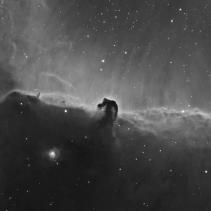IC 434
IC 434 is a bright emission nebula in the constellation Orion. It was discovered on February 1, 1786 by William Herschel. The Horsehead Nebula is a dark nebula silhouetted against it.
The Horsehead Nebula is one of the most recognizable of deep sky objects by virtue of its distinct resemblance to its namesake. It is certainly the best known example of a dark nebula. The Horsehead is also known by the less descriptive Barnard 33. The nebula is a classic dark nebula and may only be seen because it is silhouetted against the very faint glow of IC 434, a reef of tenuous emission nebulosity.
Burnhams Celestial Handbook reports that the Horsehead was first detected in photographs in 1889 by E. Pickering. Burnhams also reports that the significance of this object was not immediately recognized. Early descriptions refer to this object as a "bay" or a gap in IC 434. It appears that E. Barnard was the first to recognize that it was actually obscuring light from behind.
The Horsehead is believed to a dense cloud of tiny interstellar grains of dust that blocks the light of the emission nebula IC 434 and stars behind. While dark nebula are generally invisible (except of course where back lit as in the case of the Horsehead), their dust grains very effectively absorb light and ultraviolet radiation and then re-radiate this energy at infrared wavelengths.
The Horsehead nebula is one of the most difficult of visual objects and requires dark skies and large aperture to view.

